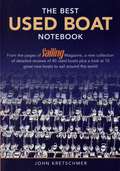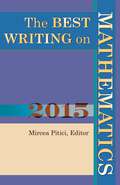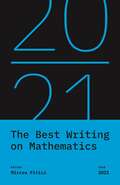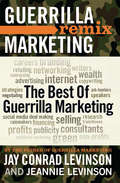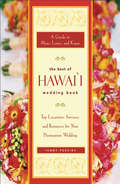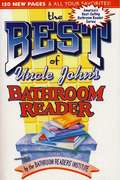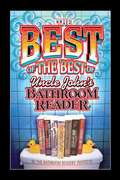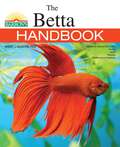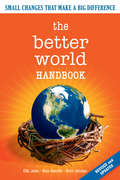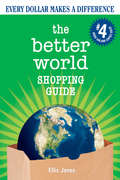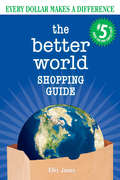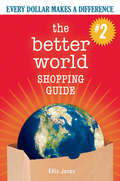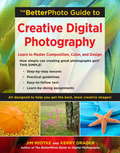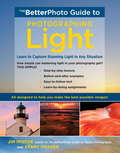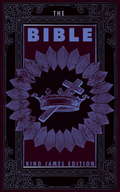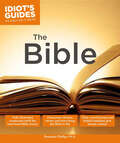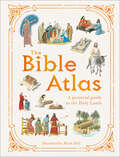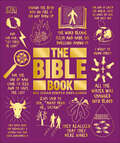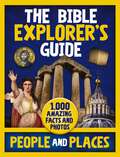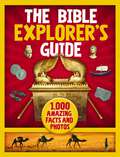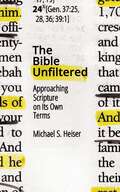- Table View
- List View
The Best Used Boat Notebook: From the Pages of Sailing Mazine, a New Collection of Detailed Reviews of 40 Used Boats plus a Look at 10 Great Used Boats to Sail Around the World
by John KretschmerWith the used boat market growing and becoming more complex, here is the book that all boat buyers have been waiting for: John Kretschmer's Used Boat Notebook has long been one of the most popular features in Sailing Magazine where Kretschmer provides a hard hitting, detailed review of a well-known boat each month.In this new collection, Kretschmer dedicates each chapter to an individual boat, providing the same fine details and updated information that made his magazine column a success. The thoroughly researched reviews of the 40 most popular boats include owner insights, a guide to common problems and suggestions on where to find parts, advice and support. There are plenty of books that offer general information on what to look for in an offshore boat, but only this book focuses on the specifics a prospective buyer is looking for.
The Best Writing on Mathematics 2015 (The Best Writing on Mathematics #14)
by Mircea PiticiThe year's finest writing on mathematics from around the worldThis annual anthology brings together the year's finest mathematics writing from around the world. Featuring promising new voices alongside some of the foremost names in the field, The Best Writing on Mathematics 2015 makes available to a wide audience many articles not easily found anywhere else—and you don’t need to be a mathematician to enjoy them. These writings offer surprising insights into the nature, meaning, and practice of mathematics today. They delve into the history, philosophy, teaching, and everyday occurrences of math, and take readers behind the scenes of today’s hottest mathematical debates.Here David Hand explains why we should actually expect unlikely coincidences to happen; Arthur Benjamin and Ethan Brown unveil techniques for improvising custom-made magic number squares; Dana Mackenzie describes how mathematicians are making essential contributions to the development of synthetic biology; Steven Strogatz tells us why it’s worth writing about math for people who are alienated from it; Lisa Rougetet traces the earliest written descriptions of Nim, a popular game of mathematical strategy; Scott Aaronson looks at the unexpected implications of testing numbers for randomness; and much, much more.In addition to presenting the year’s most memorable writings on mathematics, this must-have anthology includes a bibliography of other notable writings and an introduction by the editor, Mircea Pitici. This book belongs on the shelf of anyone interested in where math has taken us—and where it is headed.
The Best Writing on Mathematics 2021 (The Best Writing on Mathematics #20)
by Mircea PiticiThe year’s finest mathematical writing from around the worldThis annual anthology brings together the year’s finest mathematics writing from around the world—and you don’t need to be a mathematician to enjoy the pieces collected here. These essays—from leading names and fresh new voices—delve into the history, philosophy, teaching, and everyday aspects of math, offering surprising insights into its nature, meaning, and practice, and taking readers behind the scenes of today’s hottest mathematical debates.Here, Viktor Blåsjö gives a brief history of “lockdown mathematics”; Yelda Nasifoglu decodes the politics of a seventeenth-century play in which the characters are geometric shapes; and Andrew Lewis-Pye explains the basic algorithmic rules and computational procedures behind cryptocurrencies. In other essays, Terence Tao candidly recalls the adventures and misadventures of growing up to become a leading mathematician; Natalie Wolchover shows how old math gives new clues about whether time really flows; and David Hand discusses the problem of “dark data”—information that is missing or ignored. And there is much, much more.
The Best of Fred Basset
by Alex GrahamJoin Fred and co. on and off the leash, as they indulge in their favourite activities, visit the seaside, play golf, find love – and chase plenty of cats, naturally. With a whole host of old favourites plus newer friends, this very special collectable edition highlights the most memorable moments from Fred’s incredible half-century in print.
The Best of Guerrilla Marketing
by Jay Levinson Jeannie LevinsonCash in with Guerrilla Marketing's Greatest HitsUpdated, adapted, remastered...The Father of Guerrilla Marketing, Jay Conrad Levinson, and co-author Jeannie Levinson, present you with the only book to deliver The Best of Guerrilla Marketing-a combination of the latest secrets, strategies, tactics, and tools from more than 35 top selling Guerrilla Marketing books.When they write the history of marketing thought, Jay doesn't get a page... he gets his own chapter.Seth Godin, author of Poke the BoxThis book is the culmination of Guerrilla Marketing's huge footprint on the marketing landscape. Keep it on top of your desk-it will become your marketing bible. -Jill Lublin, international speaker and author, Jilllublin.comFor business survival in the 21st century, Guerrilla Marketing ranks right up therewith food, water, shelter - and, of course, Internet access.David Garfinkel, author of Advertising Headlines That Make You Rich21 million entrepreneurs around the world, including me and most of my clients & friends, owe a debt of gratitude to Jay Conrad Levinson for his inspiring Guerrilla Marketing advice and mentoring.Roger C. Parker, www.PublishedandProfitable.com
The Best of Hawaii Wedding Book
by Tammy Ash PerkinsFrom simple barefoot beach ceremonies to romantic grand hotel weddings, Hawaii is one of the most popular -- and most beautiful -- places to get married. The Best of Hawaii Wedding Book showcases the very best the islands have to offer destination brides. Written by the best local wedding planner with more than ten years of experience, the book features exclusive reviews of top wedding and reception locations, including beaches, churches, resorts, restaurants, and gardens; listings of services such as officiates, caterers, photographers, videographers, musicians, flowers, and rentals; Hawaii-specific tips; as well as resources for accommodations and transportation. Locations are pictured in black-and-white photographs, while a full-color inset features select locales and vendors. Not a catch-all directory, the book reflects the eyes and ears of a wedding professional with first-class style and impeccable taste.
The Best of Uncle John's Bathroom Reader (Bathroom Reader Ser.)
by Bathroom Readers' InstituteFind out what millions of trivia lovers already know: Uncle John is your #1 source when it comes to throne-room reading entertainment. This book celebrates the very best articles from the BRI's first ten years--plus 150 all-new pages! As always, the contents are divided by length: short articles for the reader on the go, medium articles if you have a few minutes to spare, and the extended sitting section for those truly leg-numbing experiences. Read about . . .- The origin of Twinkies- Who invented the Hula Hoop- The untold history of the Three Stooges- Space toilets: where no man has gone before- 1876: the year they stole the presidency- The FBI's "Ten Most Wanted" list- How to start your own country- Celebrity impostersAnd much, much more!
The Best of the Best of Uncle John's Bathroom Reader
by Bathroom Readers' InstituteWe stuffed the best stuff we've ever written into 576 glorious pages. Result: pure bathroom-reading bliss! You're just a few clicks away from the most hilarious, head-scratching material that has made Uncle John's Bathroom Reader an unparalleled publishing phenomenon. As always, the articles are divided into short, medium, and long for your sitting convenience. So treat yourself to the best of history, science, politics, and pop culture--plus the dumbest of the dumb crooks, the strangest of the strange lawsuits, and loads more, including . . .- The Barbados Tombs- The Lonely Phone Booth- The Origin of the Supermarket- The History of the IQ Test- Robots in the News- Tennessee's Body Farm- Happy Donut Day!- The Origin of Nachos- The Birth of the Submarine- A Viewer's Guide to Rainbows- How the Mosquito Changed HistoryAnd much, much more!
The Betta Handbook (B.E.S. Pet Handbooks)
by Robert J. GoldsteinTitles in B.E.S.'s popular series of Pet Handbooks present comprehensive information and helpful advice from breeders, veterinarians, and other pet experts. These full-color books instruct on housing, feeding, healthcare, and more. In The Betta Handbook, those interested in these brilliantly colored beginners' fishes will learn how to keep them well-fed and healthy so they can continue to brighten the aquarium tank. This book covers all the Betta varieties.
The Better World Handbook
by Ellis Jones Brett Johnson Ross HaenflerSpecifically designed to reach people who normally would not consider themselves activists, The Better World Handbook is directed toward those who care about creating a more just, sustainable, and socially responsible world but don't know where to begin. Substantially updated, this revised bestseller now contains more recent information on global problems, more effective actions, and many new resources.
The Better World Shopping Guide
by Ellis JonesAccording to the latest research, the average American family spends nearly $22,000 a year on goods and services--that's 22,000 votes for the world you want to live in. Do you want to ensure your money is supporting companies who work to make the world a better place, or risk its going to corporations who make their decisions based solely on the bottom line? The Better World Shopping Guide is the only comprehensive guide for socially and environmentally responsible consumers. This perennial bestseller rates every product on the shelf from A to F so you can quickly tell the "good guys" from the "bad guys"--turning your shopping list into a powerful tool to change the world. Drawing on decades of meticulous research, this completely revised and updated fourth edition will help you find out which companies actually "walk the talk" when it comes to: Environmental sustainability Human rights Community involvement Animal protection Social justice Small enough to fit in a back pocket or handbag and organized in a user-friendly format, The Better World Shopping Guide will help you change the world as you shop. Ellis Jones, PhD, is the award-winning, best-selling author of The Better World Shopping Guide and The Better World Handbook. A scholar of social responsibility, global citizenship, and ethical consumerism, Jones has dedicated himself to uncovering practical ways for people to make a difference in the world. He currently teaches in the Department of Sociology at Holy Cross College.<P><P> Advisory: Bookshare has learned that this book offers only partial accessibility. We have kept it in the collection because it is useful for some of our members. To explore further access options with us, please contact us through the Book Quality link on the right sidebar. Benetech is actively working on projects to improve accessibility issues such as these.
The Better World Shopping Guide #5
by Ellis JonesWhile we generally try to make our vote count every four years, few of us realize that our most immediate power to shape the world is being squandered on a daily basis. Every dollar we spend has the potential to create social and environmental change. In fact, it already has. The world that exists today is in large part a result of how our purchasing decisions have shaped it.The Better World Shopping Guide rates hundreds of products and services from A to F so you can quickly tell the "good guys" from the "bad guys" and ensure your money is not supporting corporations who make their decisions based solely on the bottom line. Drawing on decades of meticulous research, this completely revised and updated fifth edition will help you find out who actually "walks the talk" when it comes to: Environmental sustainability Human rights Community involvement Animal protection Social justiceSmall enough to fit in a back pocket or handbag, and organized in a user-friendly format, The Better World Shopping Guide will help you reward the companies who are doing good, penalize those involved in destructive activities, and change the world as you shop!Ellis Jones, PhD, is the award-winning, best-selling author of four previous editions of The Better World Shopping Guide and co-author of The Better World Handbook. A scholar of social responsibility, global citizenship, and everyday activism, Jones has dedicated himself to uncovering practical ways for people to make a difference in the world. He currently teaches at Holy Cross College.
The Better World Shopping Guide--Revised Edition
by Ellis Jones"The new edition doesn't disappoint. Pocket-sized so it's easy to carry around, and at-a-glance easy-to-read, it grades companies with a simple A to F. The grade encompasses human rights, the environment, animal protection, community involvement, and social justice. I've always believed we vote with our dollars every day, choosing through our purchases what kind of world we want to live in. This book embraces that idea, and also gives a list of 'Top 10 Things to Change' from banking and credit cards, to chocolate and coffee."--Chris, Seventh Generation blogThe only comprehensive guide for socially and environmentally responsible consumers available, this book ranks every product on the shelf from A to F so you can quickly tell the "good guys" from the "bad guys"--turning your grocery list into a powerful tool to change the world. Representing over seventeen years of distilled research, data is organized into the most common product categories including coffee, energy bars, computers, gasoline, clothing, banks, cars, water, and more. Also included is a summary of the essential information about particular product categories, profiles of the best and worst companies, practical buying tips, and the most useful online resources available. Whether you believe in environmental sustainability, human rights, animal protection, community involvement, or social justice, this book is for you!Small enough to fit in a back pocket or small purse and organized in a shopping-friendly format, The Better World Shopping Guide will help you change the world as you shop!Ellis Jones has been teaching people to make a difference in the world for over a decade with works like The Better World Handbook. A scholar of social responsibility, social change, and everyday activism, he founded and directs the Better World Network. He teaches sociology at the University of California, Davis.
The BetterPhoto Guide to Creative Digital Photography: Learn to Master Composition, Color, and Design
by Jim Miotke Kerry DragerMaster composition and design to take your photos from okay to wow You already own the most important photography tool--your creative eye. With this book, you'll learn how classic design and composition principles can be applied to a wide range of photographic situations to create images with impact. Jim Miotke and Kerry Drager, both veteran photographers and experienced instructors, share time-tested design guidelines, composition techniques, even tips on when to break the rules, that will transform the way you make photographs.From the Trade Paperback edition.
The BetterPhoto Guide to Photographing Light: Learn to Capture Stunning Light in any Situation
by Jim Miotke Kerry DragerLearn how light can breathe new life into your photos Do you take too many snapshots and not enough "wow" shots? If so, you may be spending more time thinking about your subjects than thinking about the light. In The BetterPhoto Guide to Light, veteran photography instructors Jim Miotke and Kerry Drager help amateur shooters of all levels master this basic ingredient of compelling photography. You'll learn how to identify the best light, fix common lighting problems, and, most important, take stunning photos with whatever light you have. Full of image examples, hands-on assignments, and proven techniques, this book will show you how to expand your vision and take your photography to the next level.
The Bible
by Random HouseOriginally produced for the Church of England, The King James Version is one of the most enduring translations of The Bible. It's combination of poeticism and readability have made it the most prominent version of the best-selling book in human history. Penguin Random House Canada is proud to bring you classic works of literature in e-book form, with the highest quality production values. Find more today and rediscover books you never knew you loved.
The Bible (Idiot's Guides)
by Benjamin PhillipsThe Bible is full of amazing lessons and stories, but for anyone interested in learning about what they mean and how they fit together, it can be difficult with a traditional Bible. Idiot's Guides: The Bible brings every Old Testament and New Testament book to life. This full-color book includes helpful summaries, vital statistics, key quotes and passages, and clear maps and timelines.
The Bible As It Was
by James L. KugelThis is a guide to the Hebrew Bible unlike any other. Leading us chapter by chapter through its most important stories--from the Creation and the Tree of Knowledge through the Exodus from Egypt and the journey to the Promised Land--James Kugel shows how a group of anonymous, ancient interpreters radically transformed the Bible and made it into the book that has come down to us today. Was the snake in the Garden of Eden the devil, or the Garden itself "paradise"? Did Abraham discover monotheism, and was his son Isaac a willing martyr? Not until the ancient interpreters set to work. Poring over every little detail in the Bible's stories, prophecies, and laws, they let their own theological and imaginative inclinations radically transform the Bible's very nature. Their sometimes surprising interpretations soon became the generally accepted meaning. These interpretations, and not the mere words of the text, became the Bible in the time of Jesus and Paul or the rabbis of the Talmud. Drawing on such sources as the Dead Sea Scrolls, ancient Jewish apocrypha, Hellenistic writings, long-lost retellings of Bible stories, and prayers and sermons of the early church and synagogue, Kugel reconstructs the theory and methods of interpretation at the time when the Bible was becoming the bedrock of Judaism and Christianity. Here, for the first time, we can witness all the major transformations of the text and recreate the development of the Bible "As It Was" at the start of the Common era--the Bible as we know it.
The Bible Atlas (DK Pictorial Atlases)
by DKDiscover where events in the Old and New Testaments took place and see how people lived in Biblical times in this illustrated guide.Take a trip around the Holy Land with this collection of beautifully drawn maps, which show where events from the Bible took place.Introducing The Bible Atlas – a beautifully illustrated guide to the geography, events and people of the Old and New Testaments for children aged 9-12. In illustrated guide, follow the journeys of the patriarchs, view inside Solomon's Temple, witness Jesus' miracles, and see exactly where Paul traveled while spreading the message of Christianity.Dive straight into this pictorial Bible guide for kids, offering: - An illustrated guide to key events of the Old and New Testaments for children.- A variety of maps showing in detail where events from the Bible took place.- An original and retro-feel illustration style combined with modern fonts, which creates a different approach compared to photographic or CGI-based books.As well as recapping many of the stories from both the Old and New Testaments, each page in this Bible guide provides additional information, illustrations, and photos explaining how people lived, who ruled the lands, and what places look like today. The information is presented in a visual and accessible way for children to grasp, immersing themselves in each map as they follow the stories and read summaries from the Bible.More in the seriesIf you like The Bible Atlas, then why not complete the collection? Take a peek inside the beautiful and absorbing world of birds with The Bird Atlas, explore the complex animal kingdom with The Animal Atlas, reveal the inner workings of the human body with The Body Atlas, take a trip around the globe with The Earth Atlas, and dive deep below the sea with The Oceans Atlas.
The Bible Book by Book: An Introduction to Bible Synthesis
by G. Coleman LuckA survey of the Bible as a whole, with a summary of each book's context, outline, and content.
The Bible Book: Big Ideas Simply Explained (DK Big Ideas)
by DKLearn about the scriptures of the Old and New Testament in The Bible Book.Part of the fascinating Big Ideas series, this book tackles tricky topics and themes in a simple and easy to follow format. Learn about the Bible in this overview guide to the subject, great for novices looking to find out more and experts wishing to refresh their knowledge alike! The Bible Book brings a fresh and vibrant take on the topic through eye-catching graphics and diagrams to immerse yourself in. This captivating book will broaden your understanding of the Bible, with:- Entries organized to follow the course of the Bible from start to finish- Packed with facts, charts, timelines and graphs to help explain core concept- A visual approach to big subjects with striking illustrations and graphics throughout- Easy to follow text makes topics accessible for people at any level of understandingThe Bible Book is a comprehensive guide essential to understanding the the most widely printed religious book of all time, aimed at self-educators and religious education students wanting to gain an overview. Here you&’ll find clear factual writing offering insight into key figures, scriptures and passages.Your Bible Questions, Simply ExplainedHow does God speak through prophecy? What is the significance of the Transfiguration? Explore these questions and the ideas and beliefs key to the teachings of the most widely printed religious book of all time. If you thought it was difficult to learn about one of the world&’s major religions, The Bible Book presents the information in an easy to follow layout. Learn about more than 100 of the most important Old and New Testament stories and breakdowns of some of the most well-known passages ever written from The Bible.The Big Ideas SeriesWith millions of copies sold worldwide, The Bible Book is part of the award-winning Big Ideas series from DK. The series uses striking graphics along with engaging writing, making big topics easy to understand.
The Bible Explorer's Guide People and Places: 1,000 Amazing Facts and Photos
by ZondervanFrom the world&’s leading Bible publisher, comes The Bible Explorer&’s Guide People and Places: 1,000 Amazing Facts and Photos. Packed with fun facts and full-color photos, illustrations, and maps, this book brings to life key Bible characters and places such as:The first people: Adam and EveKings and queens: King Solomon and the Queen of ShebaWarriors: Deborah and SamsonProphets: Elijah and ElishaThe tall and the small: David and GoliathThe ancient worldJerusalemAnd more!The perfect reference for reluctant readers and visual learners interested in discovering the history of the Bible and its people, The Bible Explorer&’s Guide People and Places will fascinate children 8 and up.
The Bible Explorer's Guide: 1,000 Amazing Facts and Photos
by Nancy I. SandersWhat did Noah&’s Ark really look like? Who was David and whom did he fight? What would it look like if you lived in Jerusalem in the 1st century? Get up close and personal with everyday life during Bible times through photos, maps, and illustrations of the people, places, and buildings of the Bible. From ancient customs and photos of ancient artifacts, to major festivals, customs, and 1st century food—each two-page spread is filled with images and drawings that help bring life to the people and places we could once only read about. With fascinating but brief text and full-color captivating images, this is a reference kids will come back to again and again because it is truly a one-of-a-kind Bible experience.Immerse yourself in the sights and sounds, places and tastes of Bible times … it&’s a journey you will never forget!The Bible Explorer&’s Guide:Is packed full of 1,000 amazing facts and fascinating photos showing everyday life during Bible timesFeatures gorgeous full-color photography of people, places, and artifacts in 1st century JerusalemIncludes a Bible timeline and a who's who section with mini-biographies of people from both the Old and New TestamentsContains sections such as "Problems and Plagues in Egypt", "Trumpets, Feasts, and Holy Days", and "Enter the Gates of the Holy City&”Is a great addition to any home or school library
The Bible Unfiltered: Approaching Scripture on Its Own Terms
by Michael S. HeiserThe Bible is mysterious, surprising—and often deeply misunderstood. Dr. Michael Heiser, an expert in the ancient near east and author of the best selling The Unseen Realm, explores the most unusual, interesting, and least understood parts of the Bible and offers insights that will inspire, inform, and surprise you on every page. Dr. Heiser has helped to remind the church of the supernatural worldview of the Bible. In The Bible Unfiltered, you will see his methods and expertise applied to dozens of specific passages and topics. Gleaned from his years working as Faithlife's scholar-in-residence, this is some of the very best of Dr. Heiser's work.
